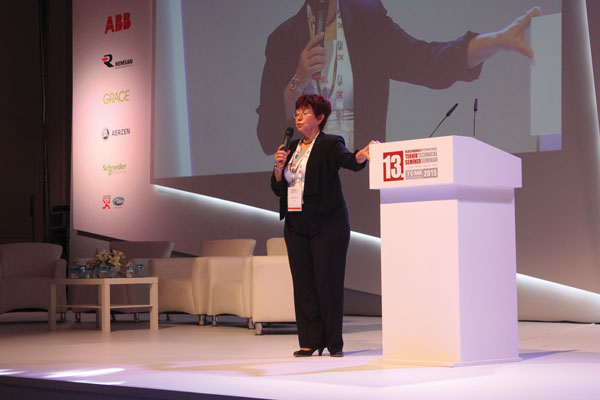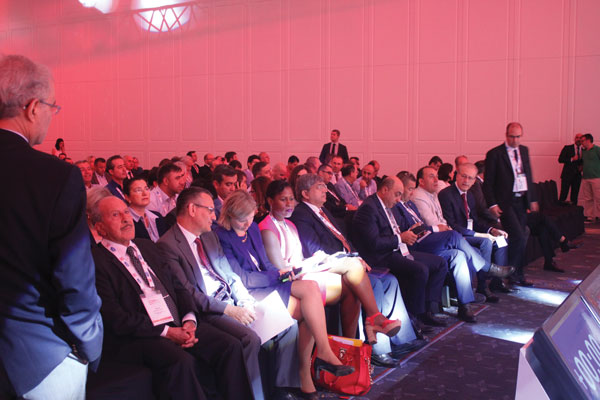13th TÇMB Technical Seminar
The 13th TÇMB International Technical Seminar and Exhibition, organised by the Turkish Cement Manufacturers’ Association, was held at the well-appointed Titanic Delux Belek Hotel in Antalya, Turkey, on 7-10 October 2015. With a two-day conference programme, a vast international exhibition and an attendance of some 550 delegates, there was a great deal to learn under the theme of ‘Sustainable Environment and Energy’.

Caglan Becan of the Turkish Cement Manufacturers’ Association welcomes delegates
to the 13th TÇMB International Technical Seminar and Exhibition in Antalya
Caglan Becan of the Turkish Cement Manufacturers’ Association (TÇMB) welcomed delegates to this year’s event which continued its long-standing tradition of creating a platform for cement sector delegates to discuss ways to drive the industry forward and enhance plant operations. This year, 17 technical presentations under the theme of ‘Sustainable Environment and Energy’ brought low-carbon cement production, alternative fuels usage and technology innovations to the forefront of the local and international audience, while regional market trends also received due attention.
Turkish industry trends
Providing an overview of the host market of Turkey, Sefik Tüzün of the TÇMB updated delegates on recent activity. Since 1911 the industry has evolved to comprise 70 production units including 52 integrated plants. Today it is the largest producer in Europe and fifth in the world rankings. In 2014 the Turkish cement sector achieved a turnover of US$4bn and contributed US$700-900m in exports, while employing 25,000 people.
In terms of the supply and demand scenario, some 75Mt of cement was produced in 2014, translating to a utilisation rate of 90 per cent. During the year, 64Mt was sold domestically as per capita consumption reached 826kg. A further 11Mt was exported, making Turkey the third-largest cement exporting nation behind China and Iran.
Arabian update
Ahmad Al-Rousan, secretary general of the AUCBM, turned the attention of delegates to cement sector activity in Arab countries. At present the Arab region’s production base comprises 164 integrated factories, 21 grinding mills and a nominal capacity of 340Mta. Actual production reached 214Mt in 2014 and total consumption was 234Mt. However, the political and economic environment in Iraq, Libya, Syria and Yemen, combined with falling oil prices, have triggered concerns that cement demand will decline in 2015-16.
Sustainability at the core

The event succeeded in attracting some
550 delegates from Turkey and beyond
The keynote speech by Aisha Williams of the International Finance Corporation (IFC) argued the need for Turkey to improve its take-up of waste heat technology in the cement sector to further improve its sustainability record. In India the IFC has partnered projects to develop energy-efficient power solutions.
Koen Coppenholle, CEO of Cembureau, provided an outline of challenges facing its members in terms of making cement production more sustainable. Specifically, he highlighted the regulatory environment and the concept of a ‘circular economy’ which includes solutions such as co-processing and complete material lifecycles.
Ashwani Pahuja, director general of the National Council for Cement and Building Materials (India), focussed on the domestic cement sector’s progress in lowering its thermal energy requirements as well as cogeneration efforts. Currently, the average thermal energy consumption reaches 726kcal/kg of clinker and electrical energy consumption stood at 78kWh/t of cement. Moreover, 15 cement plants have installed 176MW of cogeneration capacity, while CO2 emissions are targeted to be further reduced to 0.58t CO2/t of cement by 2050. Furthermore, blended cements now make up 60-70 per cent of India’s cement output, lowering clinker requirements.
A further four sessions of presentations led delegates through two days of informative papers from leading cement suppliers who also contributed to a large exhibition before the conference closed with a Gala Dinner.
Article first published in International Cement Review, December 2015.

